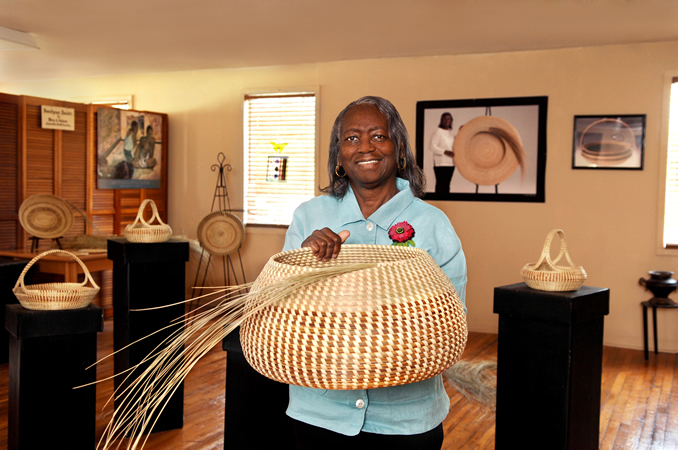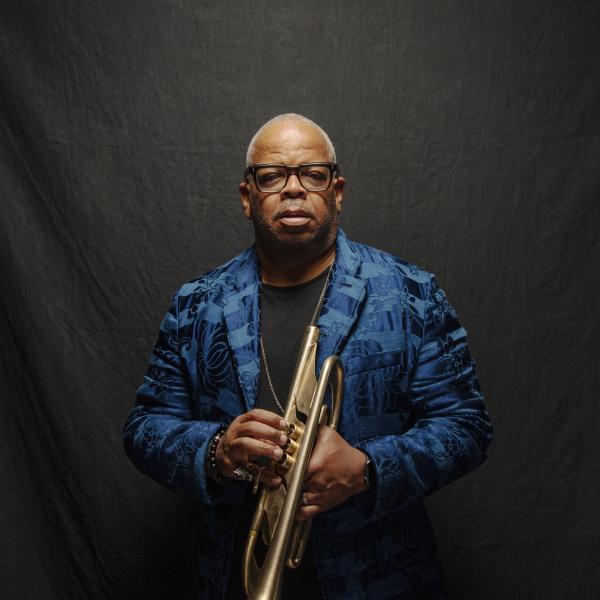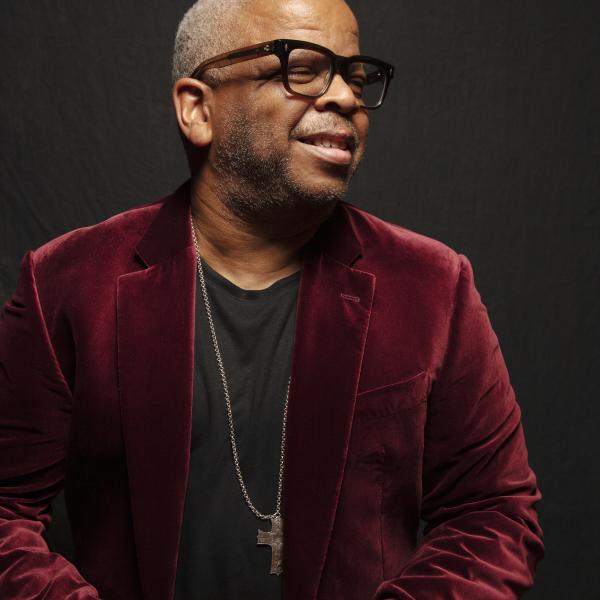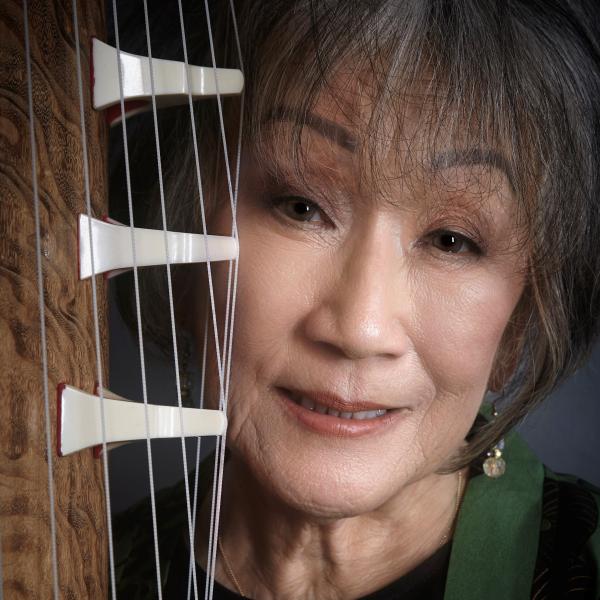Mary Jackson

Mary Jackson: Sweetgrass baskets were made for utilitarian use. And the tradition maintain a beautiful basket for everyday living. I learned all of the tradition designs from my mother and grandmother, but I wanted to introduce new forms that no one had ever thought about doing. And so this was something that was kind of new and exciting in my family before I really introduced it to the general public. And that's what I continue to do, designing forms that were never done before.
Jo Reed: That was National Heritage fellow, Mary Jackson talking about the art of sweetgrass basketmaking.
Welcome to artworks, the program that goes behind the scenes with some of the nation's great artists to explore how art works. I'm your host, Josephine Reed.
Born in coastal South Carolina in 1945, Jackson has been weaving sweetgrass baskets virtually her whole life. Traditionally, sweetgrass baskets have performed a function such as storage containers or rice fanners. But in the hands of Mary Jackson these practical designs are transformed into beautifully crafted, finely detailed, sculptural forms. She manages to preserve this centuries-old art while simultaneously innovating it. And people have taken notice.
Her work has been exhibited at museums throughout the United States, Including the Philadelphia Museum of Art, The museum of Fine Arts in Boston, and the Smithsonian American art Museum. Her baskets are now owned by people like Prince Charles of Britain and the Empress of Japan. She's received many awards and honors: including a MacArthur Fellowship in 2008 and a National Heritage Fellowship in 2010. I spoke to Mary Jackson soon after she was named a National Heritage Fellow. And I began by asking her to tell me some of the history of sweetgrass baskets.
Mary Jackson: The art of sweetgrass basket making originated from West Africa, along the Ivory Coast and the Gambia area. This basketry came with my ancestors who were brought as slaves from Africa. They made baskets, this particular style of basketry, for their everyday living. And they were brought here by plantation owners here in the South because they had the skill of cultivating rice, and rice was the main industry that was produced by plantation owners. So my ancestors had the skill of cultivating rice, and they also work with cotton and indigo. But as an added bonus, the Africans had the skill of making baskets which were very useful to plantation owners, because in the early plantation days, they did not have containers to hold grain or to ship grain. And because the rice industry was a very large industry here, they needed these vessels. So my ancestors made these large baskets that were used by plantation owners to market their rice and grains all over the country. Men made agricultural baskets for fieldwork. As well women made household baskets for everyday living. So my ancestors were regarded as valuable people because they had this particular skill that was an added bonus to the plantation owners. At the breakup of the plantation system, when families acquired land and started a new way of life, they kept this tradition going among family members because they wanted the future generation to have these baskets as evidence of why they came here and where they came. So part of our history we will always have with us. And even today it's an art form that we know came from Africa.
Jo Reed: When did you learn to weave baskets, Mary?
Mary Jackson: My mother said I was around four years old when she started teaching me. During the summer, when school was closed, this is what my siblings and I learned to do, and nearby cousins. We all made baskets during the summer months. This was something to keep us busy as well as to learn the art, and then also this was just like a summer activity for us because growing up in a rural community where I grew up, there weren't any activities for us to do. Our families could not afford to send us to summer camp. We did not even know about summer camp <laughs> It just didn't exist in the rural community just north of the city of Charleston, where I grew up. We practiced this every day, because it was a way of life for our families. So that's how I learned it.
Jo Reed: Did you like doing it when you were a kid?
Mary Jackson: Absolutely not. I did not like it because it was just hard work. We learn how to harvest the grasses for making these baskets which was very vital because there were specific grasses that were used for making these baskets. So we had to learn how to go out in the marshes and the swamps to harvest the grasses. Traditionally the men harvest the grasses, but women also learned to harvest them as well because many families did not have a male person to harvest the grasses. But as children we're taught all aspect of making these baskets, and that was part of the learning process. And then after the grasses are dried to get specific colors, they're then ready for weaving into baskets. And this was another difficult process because it's all hand done. The grasses are not wet or soaked to work with. They're woven dry. So this makes it kind of difficult on the hands. So that was one of the real drawback in making baskets. So it was never fun to me. But it was almost a chore that my mother and father, insist that we do. Because, again, it kept us busy. And then they felt it was important to learn the art form. They did not expect us to do this for the rest of our lives. Was just growing up learning to do this.
Jo Reed: Was this something that you would all do together? Like all the kids in the family would sit down and weave together?
Mary Jackson: Yes. We did sit together under big trees in my grandmother's yard which was next door to where I live. And so we would assemble, during the daytime, after we finished our household chores. And then we would make baskets.
Jo Reed: Would you compete?
Mary Jackson: I was about to say we had competition among <laughs> everyone to see who would make the prettiest basket by the end of the day or whose work was getting better and better and so this was the fun process of it.
Jo Reed: Weaving baskets at that age, do you think it taught you patience?
Mary Jackson: Oh, I don't know. Because I didn't even understand patience at that time until I got older. But I can say very truthfully today that you have to have a lot of patience. You have to have a lot of interest in carrying on the tradition. The technique is still the same. It hasn't changed. And it requires patience and dedication in order to make these baskets, because it's a slow process.
Jo Reed: Now, you moved to New York City. When did that occur?
Mary Jackson: After I finished high school, I moved to New York to find work that was not available in the community where I live and also that I could maybe go to school and learn some professional skill. And I lived in New York for about ten years. But I never stayed away from making baskets. Because when I came home for visits and vacation time, I would go and sit with my mother and we would make baskets with family members, because, again, it was still a way of life for us.
Jo Reed: But then basket making became a major focus in your life and as a result you became involved with environmental issues.
Mary Jackson: Yes. I moved back to Mount Pleasant in 1972, and I started interacting with family members in the community because basket was still being practiced on a daily basis. It was always just a wonderful-- at that time, it wasn't-- it was a wonderful skill I should say. And in communicating with many family members, they were concerned about the disappearance of their primary grass, which was sweetgrass, that it was disappearing because of development that were taking place along the coast. Areas where I went as a child, some of those areas were now under development. And they felt like we needed to find new sources for sweetgrass. I started working with-- my first job was at a community center, in the city of Charleston, working for an Episcopal diocese program, where the priest in charge knew everybody in the whole city of Charleston and possibly in the state. He was very helpful in putting me in touch with people who had property in the wetlands. We would get permission for the basket makers to go and harvest grasses from these islands where it was slated for development but with the understanding that the future would be all condos and homes and it would then become off limit for harvesting sweetgrass because the land was going to be developed. And that was a major part of my work, during that time, working in the tradition. I knew that, like many people, basket makers, that if we didn't find new sources, find a way to keep the grasses available for the basket makers then we would lose the tradition. And it became a serious threat. So that was my early work in this, and I continue making baskets for my own personal collection.
Jo Reed: When did you begin to sell your baskets?
Mary Jackson: In the early 1980s. Late ‘70s I should say, because I worked full-time for a department at the medical school here in Charleston. And people who saw examples of my work commissioned me to make baskets in the office and around the university. And so that was the early start of my selling my work. And then after I had my son, he was diagnosed for chronic asthma. And I couldn't just leave him at day care, because he was always so sick. And I gave up working so that I can be home with him. And I wanted to do something that would add an income to my family, help with the income. My husband worked full-time, but I wanted to have something that I could do. So I started making baskets that I would sell in the local city market here in Charleston where basket makers historically sold baskets from the early 1940s along with vegetables and produce. It's a city market. And so I went there on weekends and carry the baskets that I'd made during the week at home. My husband was able to take care of my son, our son, when he was off. And that was the beginning of my selling my work. It was shortly after-- and that was around 1980. During that time, my work was discovered by some art patrons, I should say, as well as local people who live in Charleston and thought they were very unusual forms. And I started getting commissions to do baskets immediately that they had never seen before. So that kind of elevated the interest in my work as well as the tradition, because it was bringing in new attention to the art form.
Jo Reed: And your work came to the attention of the Smithsonian Craft Show. How did that happen?
Mary Jackson: I applied in ‘84. And I got an invitation to bring my work to Washington to sell at the Smithsonian Craft Show, and that was really the beginning of a national event for me. Now I was showing them nationally. Shortly after that, I was getting invitation to show for different museum shows, like the Philadelphia Museum of Art. I got an invitation to bring my work to Chicago. And so this was all something that I had never experienced before. But it was exciting, because people had a real interest in what I was doing. And I felt, too, that, the basket makers in our local area, they would also enjoy some benefits from this as well. Because people would come to visit Charleston to see these baskets, people who had never been to Charleston before, although many people were aware of it in the past because it was a tradition that has been practiced for many generations. And women sold baskets along the roadside in the community where I grew up just north of Charleston along Highway 17. Travelers who traveled from Maine to Florida would see stands sitting on the roadside with baskets. And also they were sold in the city market, because my grandmothers used to sell their baskets as well sometimes in the city market with their vegetables. So a whole new attention was coming to this art form. But I also wanted to bring my work into the art world where it has never been before.
Jo Reed: What was that like for you, I mean, to have your work seen nationally with the Smithsonian Craft Show and suddenly you're in museums in Philadelphia, New York and Chicago?
Mary Jackson: It was very exciting. I just got really, really excited. And my husband said to me, he says, "Well, you know, if you want to travel with your work to show," he said, "it's a beautiful art. And what you're doing is very wonderful. I will take my leave time and just take days off so that I can accompany you." Because there was no way that I was going to travel all over the country by myself. So he shared that part of this experience with me. And it was very, very exciting to meet artists who were doing different kinds of work in all media. And to be a part of that was just really, really exciting for me.
Jo Reed: What you've managed to do is keep alive a tradition of sweetgrass basket weaving but, at the same time, innovate it.
Mary Jackson: Yes. And that was part of my goal to really bring it to a new level of interest. And I think it happened more quickly than I even imagine.
Jo Reed: Your people are in the Gullah community.
Mary Jackson: Gullah is a language, an African language, that we speak, which is more like West African Creole, which has been preserved from our heritage. But the language is spoken by descendents of Africans along the Sea Island coast of South Carolina and southern Georgia. So I grew up in Mount Pleasant which is north of the city of Charleston and north of Johns Island where Gullah is spoken by descendents of Africans all the time, every day. But you can travel along the Sea Island coast south of Johns Island, and people speak the same language.
Jo Reed: Do you have a studio? Where do you weave?
Mary Jackson: I have a studio outside of my home, and it's about three miles away from where I live. And I've always tried to practice my work or make my baskets in a setting where I would have uninterrupted time from the public that I can produce the kind of work that I like doing. This has been, at the very beginning, what I wanted to do. And my studio's kind of not known to many people. People come in by appointments if they want to see my work, and then I work on commission for the public. If they would like to have some of my work, they come in by appointment. Or when I'm doing a show, like the Smithsonian Craft Show or like other shows across the country, I sit and make up work that I can bring to the show, that I can show different designs and sizes to the general public.
Jo Reed: Okay. Here's a ridiculous question. But I'm really curious. About how long does it take you to make a basket?
Mary Jackson: Well, that's not a ridiculous question, and it's asked over and over and over again. And my answer is always still the same. I have a system of working that-- I don't know how other people who make basketry do. But I work with lots of pieces in progress. I'll start a whole collection of different designs, different sizes. And so I work a little at a time and back and forth on different baskets until I start completing something. But that's only my way of working. And in my studio, at any given time, you'll find lots of baskets, from very small starting to sides being built up on small, medium or large sizes. So I never can tell how long it's going to take. Some pieces have sat in my studio for three and four years before it's finished, but I'm always working on something. So that's my answer.
Jo Reed: Now, in 2008, that was a pretty big year for you, wasn't it?
Mary Jackson: It was a mind-blowing year. And even when it's mentioned, tears come to my eyes, as it is now. When I was awarded a MacArthur Fellowship, it was just unbelievable. I've always known about the MacArthur awards, but never did I even imagine that I would get a telephone call one morning. And this gentleman who called me said, "Congratulations. You've been awarded a MacArthur Fellowship." And I nearly fell off my chair in my studio. It was just so exciting. I couldn't even think for the rest of the day. It seemed like my whole world around me got silent.
Jo Reed: What an affirmation.
Mary Jackson: And working all the years that I've been working doing what I love doing. The pleasure for me was to see how people receive my work, because it was sought after. People enjoyed what I do. And, collectors of fine basketry, they were always knocking on my door. So I kept busy with this pleasure of making my work. And to get this affirmation, it was just unbelievable.
Jo Reed: And then who comes along but the National Endowment for the Arts with its National Heritage Fellowship award.
Mary Jackson: And the National Heritage award was one that I had always coveted I guess. Early on, I always said, "Gee, I wish when I get old that I would get that award." Because it is a huge honor, and I never, never imagined getting a letter from them saying that I'd been awarded. And now I am old I consider. I'm 65 years old <laughs>.
Jo Reed: 65 is the new 40, Mary.
Mary Jackson: Okay.
Jo Reed: <laughs>
Mary Jackson: <laughs> But it was just exciting. Because it was something-- it was an award that I felt was just an honor, a real honor, to get and even early on in my career. Because I've always known people who-- there were several people from my area who had received the award over the years. But I never thought about them considering me.
Jo Reed: Well, you're keeping this tradition alive and you're passing it to the next generation, aren't you? Your daughter weaves as does your granddaughter.
Mary Jackson: Yes. My granddaughter is in the learning process. She's now 12 years old. And during the summertime, when she's not busy with camp or some other activity, she comes to the studio with her mother, my daughter, April. And, April, I've taught her since she was a little girl. So she's mastered the techniques, and she doesn't weave on a daily basis. She have no interest in doing what I'm doing. But she always felt like she wanted to know it, that one day it would go on from her to her daughter. And so I've passed it on, and I'm continuing to pass it on.
Jo Reed: Many, many congratulations, Mary. Your art is beautiful, just beautiful.
Mary Jackson: Thank you very much. It's my pleasure to talk with you.
Jo Reed: Thank you. That was National Heritage Fellow, Mary Jackson talking about the art of sweetgrass basket weaving. You've been listening to Art Works, produced at the National Endowment for the Arts. Adam Kampe is the musical supervisor.
Excerpts from "Annibelle June" from the album Appalachian Picking Society by Abigail Washburn and Bela Fleck.
The Art Works podcast is posted every Thursday at www.arts.gov. And now you subscribe to Art Works at iTunes U….just click on the iTunes link on our podcast page.
Next week, National Medal of Arts recipient and film composer extraordinaire …John Williams.
To find out how art works in communities across the country, keep checking the Art Works blog, or follow us @NEAARTS on Twitter. For the National Endowment for the Arts, I'm Josephine Reed. Thanks for listening.
NEA National Heritage fellow Mary Jackson talks about the art and tradition of sweetgrass basketmaking.




